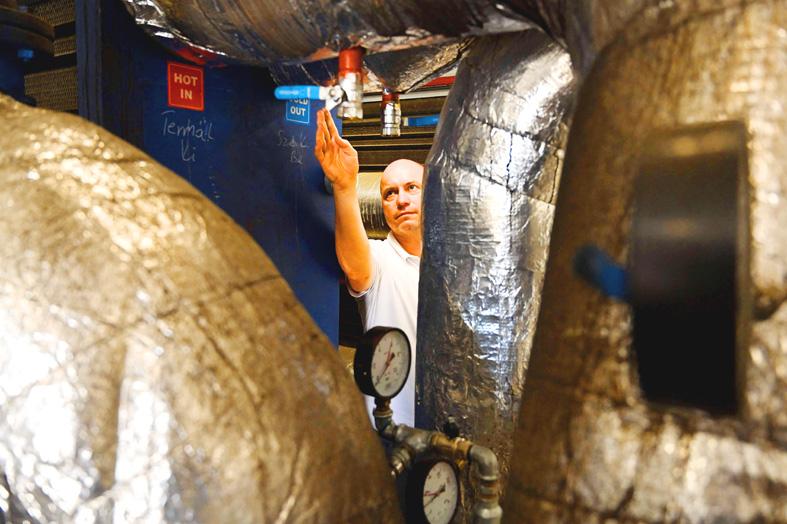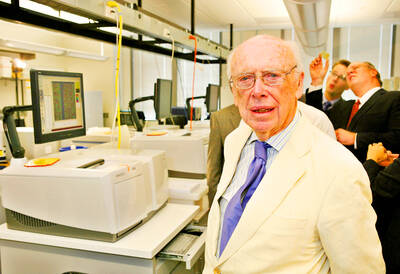At plants painted with birds and hedgehogs, hot water from deep underground is being channeled to produce energy and heat for thousands of households in Szeged, Hungary’s third-largest city.
Experts say the project — billed as Europe’s biggest urban heating system overhaul — can serve as a model for other cities across the continent, as EU nations scramble to wean themselves off Russian gas after Moscow’s invasion of Ukraine.
“Geothermal energy is local, accessible and renewable so why not use it,” geologist Tamas Medgyes told Agence France-Presse (AFP) beside a recently completed well in the middle of a residential neighborhood.

Photo: AFP
The city of 160,000 people, about 170km south of Budapest, is one of 12 in the landlocked central European country with geothermal district heating.
When the system is fully built out next year, 27 wells and 16 heating plants are to push geothermally heated water through 250km of pipes to heat 27,000 housing units and 400 nonresidential consumers.
This would make it Europe’s biggest geothermal urban heating system outside of Iceland.
However, unlike in the Icelandic capital, Szeged’s heating systems were built to run on gas.
EU member Hungary covers 65 percent of its oil needs and 80 percent of its gas needs with imports from Russia.
“This housing project was built in the 1980s. Since then we have burnt millions of cubic meters of imported Russian gas to heat cold water in these apartments,” Medgyes said.
However, now “we drilled down and got the hot water beneath our feet,” he said about the project, whose cost of more than 50 million euros (US$50.9 million) is partly covered by EU funds.
He added that the project can be a “blueprint” for cities in parts of France, Germany, Italy or Slovakia that are rich in geothermal deposits.
Experts says geothermal energy is an underutilized source of renewable heat in Europe.
“The geothermal urban heating development in Szeged is an easy-to-adopt example in many regions of Europe,” said Ladislaus Rybach, an expert at the Institute of Geophysics in Zurich, Switzerland.
Lajos Kerekes, a research associate at the Regional Centre of Energy Policy Research, told AFP that more than 25 percent of the EU’s population lives in areas suitable for geothermal district heating.
Long before the Ukraine war, Balazs Kobor, a director at Szeged heating firm Szetav, began exploring how cities can use geothermal energy and “knocking on doors of decisionmakers.”
In 2015, the city appointed him and Medgyes to initiate the integration of renewable energy sources into district heating.
“To heat the city annually the firm was burning 30 million cubic meters of gas and producing around 55,000 tonnes of carbon emissions every year,” Kobor said. “The city itself was its biggest carbon emitter.”
Kobor said that replacing gas by geothermal energy would slash the city’s annual greenhouse gas emissions by 60 percent — or about 35,000 tonnes.
If similar small to medium-sized cities switched their district heating to geothermal energy, it would be “a major step toward a carbon neutral, sustainable Europe,” he said.
Surrounded by the Carpathian and Alps mountain ranges, Hungary — and especially the area around Szeged — forms a basin where 92°C to 93°C hot water collects as deep as 2,000m below ground.
In facilities adjacent to the wells, “heat exchangers” comprising hundreds of metal panels transfer the heat to water in pipeline circuits that serve separate neighborhoods.
The geothermal water itself does not enter the circuits, but re-enters the earth through a “reinjection” well nearby, Medgyes said.
In another neighborhood, a noisy drill is gradually working its way deeper and deeper into the ground, adding sections of pipe as it goes.
The drilling period takes about three months, Medgyes said.
While residents can see and hear the drills as they work, after the work is done, they do not notice the change of heat source in their homes.
“The radiators and tap water are as warm as before. I don’t feel any difference,” Gabriella Maar Pallo, a 50-year-old clerk, told AFP in her nearby apartment.

James Watson — the Nobel laureate co-credited with the pivotal discovery of DNA’s double-helix structure, but whose career was later tainted by his repeated racist remarks — has died, his former lab said on Friday. He was 97. The eminent biologist died on Thursday in hospice care on Long Island in New York, announced the Cold Spring Harbor Laboratory, where he was based for much of his career. Watson became among the 20th century’s most storied scientists for his 1953 breakthrough discovery of the double helix with researcher partner Francis Crick. Along with Crick and Maurice Wilkins, he shared the

OUTRAGE: The former strongman was accused of corruption and responsibility for the killings of hundreds of thousands of political opponents during his time in office Indonesia yesterday awarded the title of national hero to late president Suharto, provoking outrage from rights groups who said the move was an attempt to whitewash decades of human rights abuses and corruption that took place during his 32 years in power. Suharto was a US ally during the Cold War who presided over decades of authoritarian rule, during which up to 1 million political opponents were killed, until he was toppled by protests in 1998. He was one of 10 people recognized by Indonesian President Prabowo Subianto in a televised ceremony held at the presidential palace in Jakarta to mark National

US President Donald Trump handed Hungarian Prime Minister Viktor Orban a one-year exemption from sanctions for buying Russian oil and gas after the close right-wing allies held a chummy White House meeting on Friday. Trump slapped sanctions on Moscow’s two largest oil companies last month after losing patience with Russian President Vladimir Putin over his refusal to end the nearly four-year-old invasion of Ukraine. However, while Trump has pushed other European countries to stop buying oil that he says funds Moscow’s war machine, Orban used his first trip to the White House since Trump’s return to power to push for

LANDMARK: After first meeting Trump in Riyadh in May, al-Sharaa’s visit to the White House today would be the first by a Syrian leader since the country’s independence Syrian President Ahmed al-Sharaa arrived in the US on Saturday for a landmark official visit, his country’s state news agency SANA reported, a day after Washington removed him from a terrorism blacklist. Sharaa, whose rebel forces ousted long-time former Syrian president Bashar al-Assad late last year, is due to meet US President Donald Trump at the White House today. It is the first such visit by a Syrian president since the country’s independence in 1946, according to analysts. The interim leader met Trump for the first time in Riyadh during the US president’s regional tour in May. US envoy to Syria Tom Barrack earlier